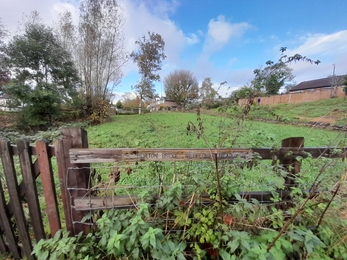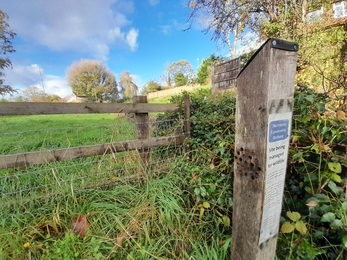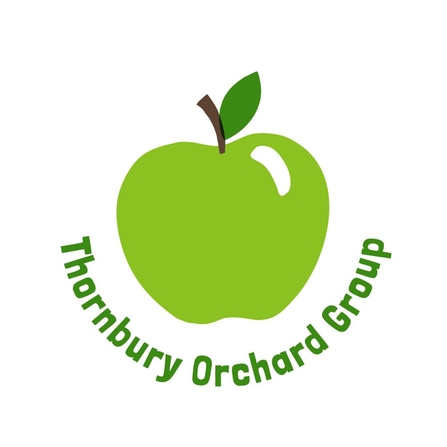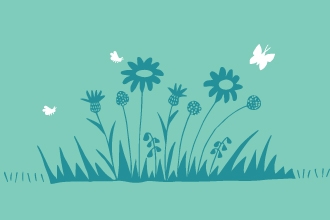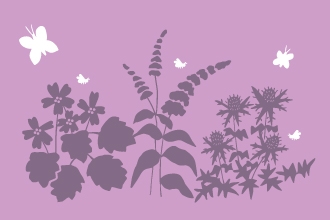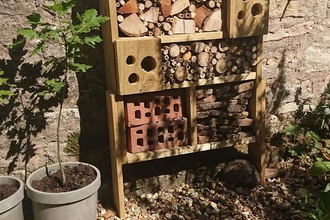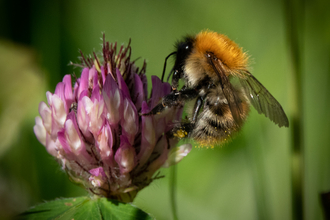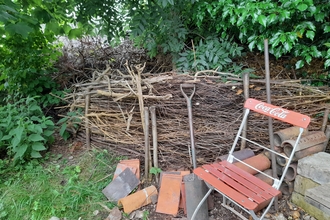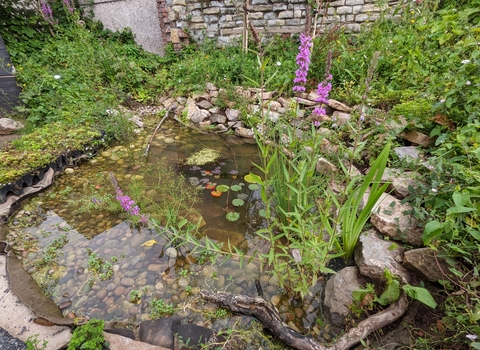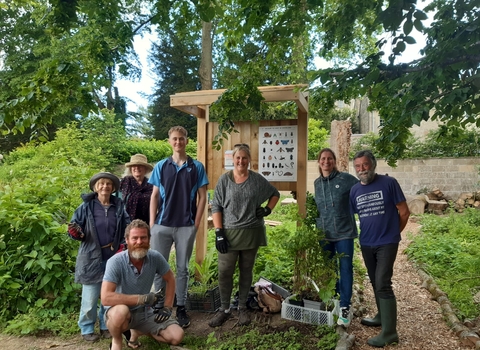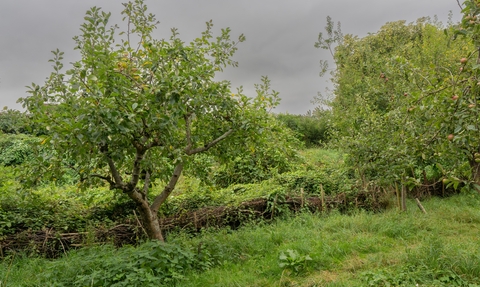
Stephanie Chadwick
Thornbury Orchard Group
Orchard, wildflower meadow, bee bank, river walk and more!
The group of volunteers at Thornbury Orchard Group are a dedicated, knowledgeable, sociable and enthusiastic bunch of volunteers - genuinely welcoming and down to earth. They spend a lot of time managing the site for the benefit of wildlife and the many human visitors to the beautiful site. They also won a Bee Bold Award in 2022. Definitely worth a visit!
They're part of the Sustainable Thornbury Group, which aids and promotes food growing and climate action on a local level, with good relationships with parish and town councils and South Gloucestershire Council.
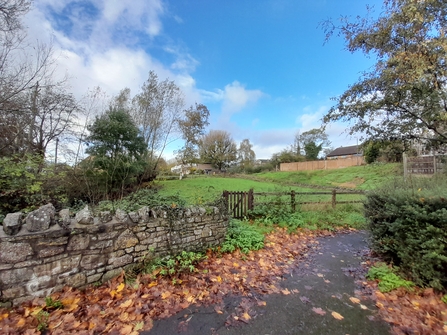
Sophie Bancroft of Thornbury Orchard Group
Community Wildflower Meadow
The wildflower meadow was seeded in 2016 and is an important 'restaurant' for the local bees and other wildlife. It is managed by the group. After a visit from the Team Wilder Community Ecologist, a question was asked about meadow management: Oxeye daisy were sown into the meadow area on site and used to flower in high numbers, but now don't. The oxeye daisy on the Bee Bank have been more successful. Yellow rattle has also been failing.
Oxeye daisy’s are a short lived perennial which establish quickly and are known as a pioneer plant. The species readily takes to bare ground and flowers from the second year onwards before other perennial wildflowers are able to establish and grow. Oxeye daisy’s need disturbed, open soil in order for the seeds to successfully establish, preferring well-drained soils in full sunlight. The site of the wildflower meadow is quite wet and includes other wildflowers and grasses. It was recommended to focus on other perennial species in the meadow, more suited to the conditions.
Yellow rattle is an annual and therefore relies on self-seeding. When the plants die, they self-seed into the surrounding bare ground. A number of factors can influence the success of yellow rattle establishing in a meadow; including the need to be sown in autumn with fresh seeds, good contact with low to medium fertility soil. It is difficult to establish with coarser/’tussocky’ grasses (e.g. cock’s foot and perenial ryegrass), which is abundant within the meadow. It was advised the cornfield annuals are sown in the autumn alongside yellow rattle seeds, to act as a ‘nurse plant’. Try in small patches, where cocks foot has been removed and create 50% bare ground within particular areas, to see if the yellow rattle establishes.
The meadow is their restaurant. In the Orchard they collect food but the orchard is also their place of work which is pollinating our fruit. They nest in the Bee Bank, the orchard wall, dead trees and wooden posts on site. Some use mud from the stream bank to build a nest while others cut off a circle of leaf. You can find all of this going on at our site.Thornbury Orchard Group
Bee bank at Thornbury Orchard Group
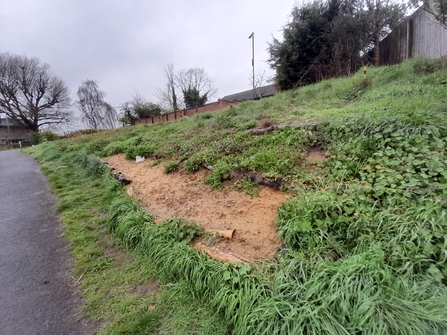
Sophie Bancroft
The Bee Bank was created in 2019 with hands on help from Sally Pattison Biodiversity Officer at South Gloucestershire Council. The local building merchants GAPS supplied the sand and gravel. The bees only like pit sand.
ADVICE: It's important to let people know that this is a bee back so they don't climb on it! Signs are used here.
The Orchard
The orchard is home to many varieties of trees - each labelled and looked after in a traditional and sustainable way. Interesting history of the orchard dates back over 200 years, evidenced with maps when the site was home to a Mill, powered by the Pickedmoor Lane stream. The site was owned by the local miller when Queen Victoria came to the thrown. His mill pond was just over the road, where the stream still flows under and the Mill, a little further down stream.
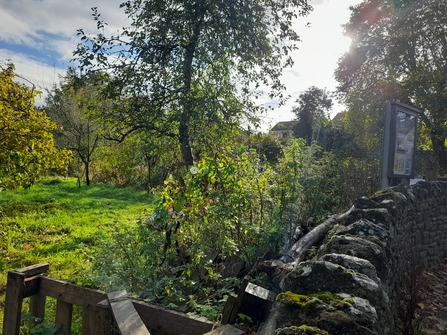
Sophie Bancroft of Thornbury Orchard Group
Two old cider apple trees are still present from the earlier orchard! The community orchard as it is known today, was created in the 1990s, when new trees were planted. In 2022, as part of the Queen's Jubilee celebrations, over 70 trees and shrubs were planted in the orchard. John and Eileen Mills, who help manage the site, have used tree DNA to identify tree species and solve local tree origin mysteries, except for one cider tree which remains unlisted.
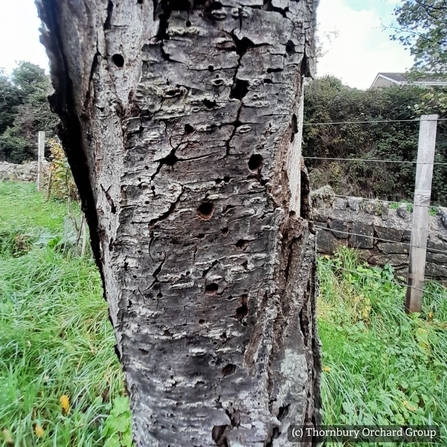
Thornbury Orchard Group
New trees planted include Gloucester Royal, Berkeley Pippin, Lemon Roy, Rhead's Reinetter, Arlingham Schoolboys and many more! They grow many varieties of cider, cooking and eating apples and plumbs.
ADVICE: Old trees are doubled up as cosy bee habitats.
Signage to spread the message
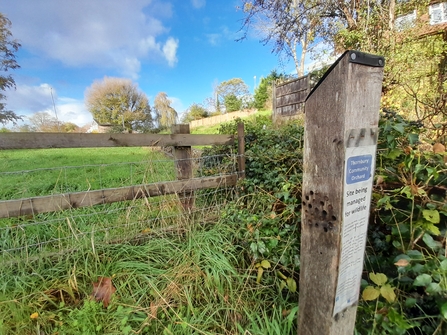
Sophie Bancroft of Thornbury Orchard Group
Don't you love the signage post doubling up as a bee hotel? Clever nature friendly design. The group commented "It is surprising how much wildlife actually lands on the post itself".
Actions for wildlife
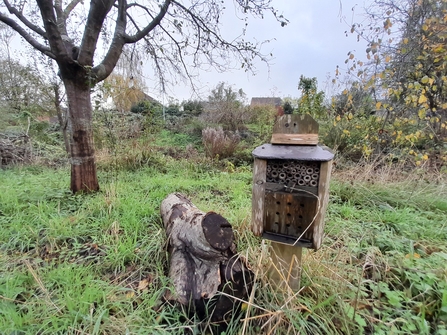
Sophie Bancroft of Thornbury Orchard Group
As well as the orchard, wildflower meadow, bee bank and butterfly bank, various training and research has lead to the successful implementation of wildlife friendly and sustainable practices and tasks to help increase biodiversity on the site.
- Dead hedges, from all of the orchard pruning, welcomed by wrens, jays, blackbirds and buzzards.
- Native hedgerows, including hazel, hawthorn, wild rose and spindle.
- Pollinator friendly plants added, such as kidney vetch, buddleia, great mullein, birdsfoot trefoil and alder buckthorn.
- Winter flowering plants, such as winter honeysuckle
- Bug hotels and log piles
- Birdboxes and bird table
- Composting on site
- Scything to manage the site, after training
Biodiversity is increasing under our stewardship. We are noticing more and more species including a few rarer and red listed species.Thornbury Orchard Group
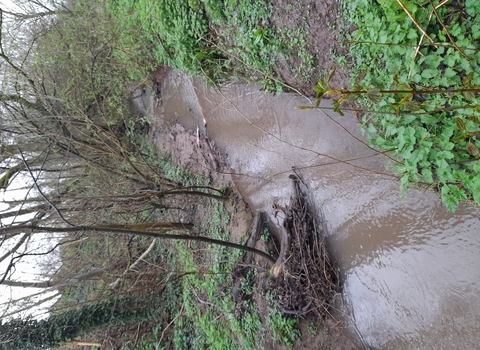
Sophie Bancroft
River management actions for nature to reduce flooding
Challenge: flooding and erosion of the stream bank
- Riparian zone: flooding of the area has changed the ecology and eroded the stream bank. The area is well-used by the public and dogs. A report has been written by BART (Bristol Avon Rivers Trust) and this gives some recommendations on how to improve the river corridor and stabilise the bank. Additional advice is required to see how the river banks could be stabilsed through native planting and how future flooding and eroding of the banks could be minimised.
Solutions: native plants on the river bank and riparian corridor, berms and leaky dams
- Suitable native species to be planted along the river banks to help stabilise the banks. Additional planting of scrub and other vegetation to minimise the flooding along the riparian corridor.
- The creation of berms and leaky dams within the watercourse to reduce bankside erosion and flooding.
River management training and clear up
Advice from the Team Wilder Community Ecologist:
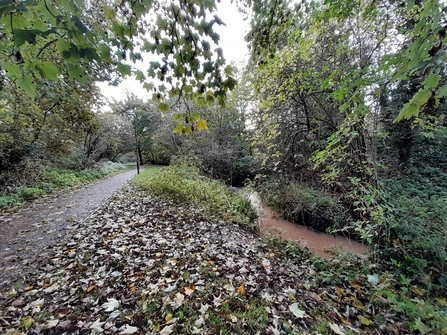
Sophie Bancroft of Thornbury Orchard Group
The streamside walk is enjoyed locally as a peaceful place to walk in nature and links the orchard, meadow and bee bank to other nearby walks and the local houses. It is a great habitat for wildlife and asset to the space.
Water management and clear up was assisted and funded by the Bristol Avon Catchment Partnership to clear a section of the Pickedmoor Lane Stream, improve flood management from local housing developments and training to improve biodiversity, river health and sustainability on the site.
Riparian management
Access for dogs It is likely that the eroding of the bank has been partly caused by the use of dogs. The limited vegetation along the stream to stop dogs from entering the channel at any point. Limited access points can be created by planting native vegetation on the bankside.
Stabilising the bankside
- Plant rhizomatous species alongside the bankside to form dense root mats beneath the soil. Eg. Nettles, purple loosestrife, common reed, greater pond sedge, yellow flag iris and meadow sweet. NB They spread quickly so will need to be managed (e.g. cut off the faded flower heads before the seed ripens and falls). They’re also beneficial for pollinators. Look at seed mixes for ponds and watercourses to help stabilise the banks.
- Planting tree and scrub species alongside the bank will help stabilise the soil. E.g. Goat willow is fast growing, prefers wet conditions and can be easily managed through coppicing.
- Sow an annual ryegrass into the bankside (such as Westerwold Ryegrass) as it is capable of extremely fast growth and can help with controlling erosion and act as a nurse plant for perennials. However, supplier advice is needed about specific management, such as frequent cutting and the immediate removal of arisings.
- Dead hedging could be created alongside the footpath, using the coppices from the willow, in order to form a natural barrier to walkers and dogs. The feature would also act as a good shelter/refuge for wildlife.
- Other recommended species alongside the river corridor (suitable for wet conditions) are blackthorn, dogwood and hawthorn.
- Create ‘tussocky’ grassland alongside the river corridor (between patches of scrub) and on the steep slopes either side of the footpath, to slow the surface run-off flow. These steeper slopes during heavy rainfall will act as a buffer along the watercourse, reducing flooding.
- The woodland on the southern side of the watercourse could be thinned in order to allow more light to reach the understorey, especially along the western part of the river. Vegetation will then be able to grow on the northern side of the watercourse and help to stabilise the bankside.
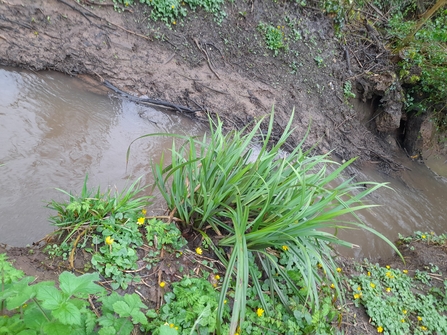
Sophie Bancroft
Natural features
- Berms (near flattened vegetation close to the low flower water level) are starting to form along the banksides. These features are beneficial and they will diversify the flow, reinstate more natural processes, re-meander the river and create another habitat for riparian species. Overtime, vegetation will start to form on berms which will enhance the habitat for biodiversity.
- Leaky/woody dams could be created upstream as these features slow the flow of water downstream and also increase sediment/silt retention. Therefore, the feature also increases the water quality downstream. These are recommended to mitigate against the flooding issues and sediment build up.
Resources
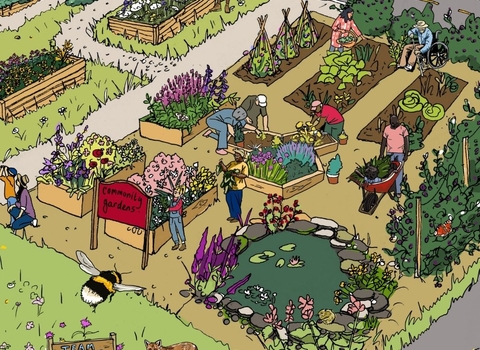
(C) Hannah Bunn
Be part of Team Wilder
All actions for nature collectively add up and creates life for people and wildlife.
Share your actions for nature, like Tom by sharing and tagging @avonwt on social media and
Log your actions for nature on the map

